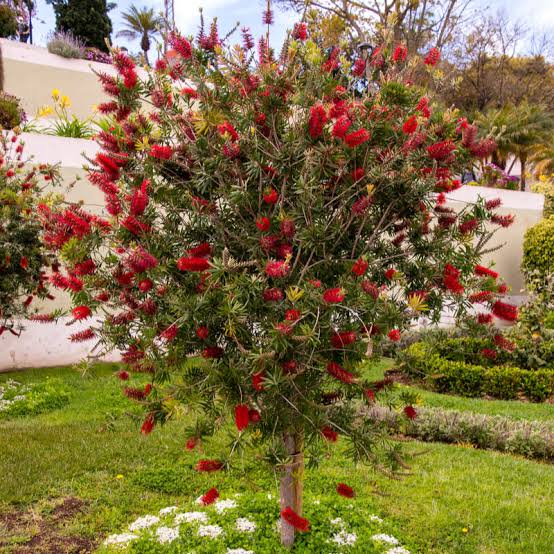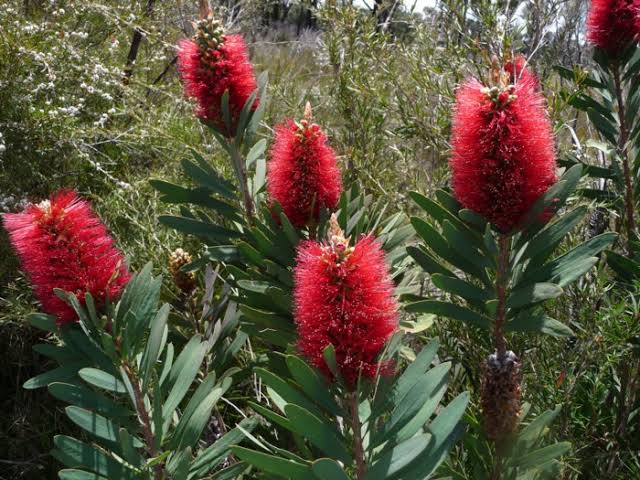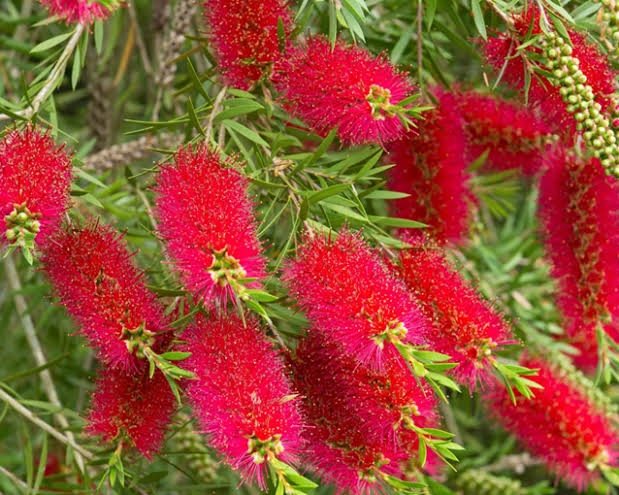Overview
Native to Australia, bottlebrush plants are a group of approximately 50 evergreen bushes that get their name because the bristled flowers they produce resemble the kind of brush used to clean the inside of a baby’s bottle. The plants feature cylindrical, bushy-stamened flowers in a range of red, yellow or pink which appears brighter against needle-like, gray- to deep-green foliage.
Drought- and salt-tolerant, these plants are often grown as shrubs but can be grown as a bottlebrush tree, reaching heights of up to 25 feet. Although the blooms don’t have a fragrance, the bottlebrush leaves release a lemony scent when bruised.
While bottlebrush plants are great for attracting hummingbirds and butterflies, they also attract bees, which is great for promoting pollination. Most varieties bloom throughout summer, with flowers tapering off as the growing season draws to a close. Outside of their hardiness zones, bottlebrushes are often grown as house or conservatory specimens.
1. Crimson Bottlebrush (Melaleuca citrina )

Melaleuca citrina, commonly known as common red bottlebrush, crimson bottlebrush is a shrub growing to 5 m (20 ft) tall but more usually in the range 1–3 m (3–10 ft) high and wide, with arching branches clothed with lance-shaped leaves that emerge coppery before maturing to gray-green. The leaves release a lemony scent when bruised.
The plant has hard, fibrous or papery bark and its young growth is usually covered with soft, silky hairs. The flowers are red and arranged in spikes on the ends of branches that continue to grow after flowering and sometimes also in the upper leaf axils. This variety is great for foundations, hedges, wall-side borders, Mediterranean gardens, city gardens or containers.
Melaleuca citrina occurs in near coastal areas of New South Wales, including the Blue Mountains and extends as far west as the Central Western Slopes. It also occurs in the east coast areas of Victoria and grows in swamps and along creeks and rivers.
2. Weeping Bottlebrush (Melaleuca viminalis)

Melaleuca viminalis, commonly known as weeping bottlebrush or creek bottlebrush is a multi-trunked, large shrub or tree with hard bark, often pendulous foliage and large numbers of bright red bottlebrush flowers in spring and summer. It is possibly the most commonly cultivated melaleuca in gardens and its cultivars are often grown in many countries.
The flowers are bright red and are arranged in spikes on and around the ends of branches which continue to grow after flowering. Flowering occurs from September to December and often sporadically throughout the year. Flowering is followed by fruit which are woody capsules. This melaleuca occurs along the eastern part of Queensland from the Cape York Peninsula south to Moree and Grafton in New South Wales.
Also Read: Different Types of Maple Trees For Your Home Landscaping
3. Stiff Bottlebrush (Callistemon rigidus)

Callistemon rigidus is native to New South Wales in Australian where it grows from 2-3m tall with a stiff erect habit. Callistemon are evergreen shrubs in general, with very aromatic, linear to lance-shaped leaves, especially when crushed. It is a rather desirable shrub in the Myrtaceae family with striking crimson red (bottle brush-like) flower spikes with darker anthers, produced in late spring to summer.
4. Albany Bottlebrush (Melaleuca glauca)

Melaleuca glauca, commonly known as Albany bottlebrush is a shrub growing to 3.5 m (10 ft) tall with hard, fibrous bark and glaucous leaves. The flowers are bright red and arranged in spikes on the ends of branches which continue to grow after flowering. Flowering occurs from October to December and is followed by fruit which are woody capsules.
Melaleuca glauca occurs in the south and south-western coastal districts of Western Australia between Perth and Albany in the Jarrah Forest, Swan Coastal Plain and Warren biogeographic regions, where it grows in swampy ground in sandy or clayey soils.
5. Lemon Bottlebrush (Callistemon citrinus)

The Lemon bottlebrush can be grown as a large shrub or small tree with a mounding habit 15-25 ft. tall, 15-20 ft. wide. Citrus-scented leaves are pointed and 3-4 in. long; new growth emerges soft and reddish before maturing pale green and hard. Striking red flowers comprised of numerous stamens occur in large brush-like spikes, 3-4 in. long, during mid spring and also intermittently all year.
Also Read: Different Types of Japanese Maple Trees
6. Alpine Bottlebrush (Melaleuca pityoides)

Melaleuca pityoides, commonly known as alpine bottlebrush is a shrub growing to 3 m (10 ft) high and often occurring in dense thickets, with hard bark, silvery-grey new growth, almost cylindrical leaves. The young leaves and branches are often densely covered with silky hairs. The flowers are golden-yellow to cream, sometimes tinged with pink or green, and are arranged in short spikes on the ends of branches which continue to grow after flowering.
7. Cliff Bottlebrush (Melaleuca comboynensis)

Melaleuca comboynensis, commonly known as cliff bottlebrush, is a shrub similar to Crimson Bottlebrush with its hard leaves, spikes of red flowers and clusters of cup-shaped fruits but differs in that its leaves are generally wider and its habitat is usually rocky outcrops rather than along watercourses. The flowers are arranged in spikes usually near the end of the branches. Flowering occurs from March to December and is followed by fruit that are woody capsules.
8. Wallum Bottlebrush (Melaleuca pachyphylla)

Melaleuca pachyphylla, commonly known as wallum bottlebrush, is a medium-sized shrub growing to 3 m (10 ft) tall. The flowers are usually crimson but sometimes greenish-yellow. They are arranged in spikes on the ends of branches that continue to grow after flowering and also on the sides of the branches. Flowering occurs in summer and is followed by fruit that are woody capsules.
Also Read: Major Types of Cypress Trees For Landscaping
9. Needle Bottlebrush (Melaleuca orophila)

Melaleuca orophila, commonly known as needle bottlebrush or Flinders Ranges bottlebrush, is a medium-sized shrub with sharp-pointed, needle-like leaves. The plant grows up to 2 m (7 ft) tall with hard, fissured bark and rigid branches. The flowers are bright red or orange-green and arranged in spikes on the ends of branches which continue to grow after flowering and also on the sides of the branches. . Flowering occurs in spring and is followed by fruit which are woody capsules.
10. Willow Bottlebrush (Melaleuca salicina)

Melaleuca salicina, commonly known as willow bottlebrush, is a shrub or small tree growing to 20 feet high with soft, pink new growth and white or grey papery bark. The flowers are white or creamy-white and are arranged in spikes at the end of, or around the branches which continue to grow after flowering. The species is suited to a wide range of soil types, and can tolerate both wet and dry conditions and near-coastal exposure but it is not frost tolerant.